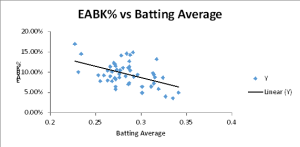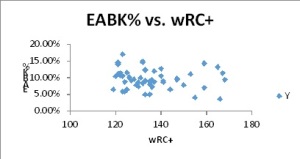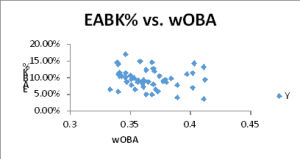Last night, I was lying in bed with my arms crossed behind my head, staring at my ceiling, and thinking of what a fantastic season Paul Goldschmidt is having. “He’s so locked in; I wonder how pitchers have pitched him differently over the course of this season; I bet he’s super cool; I bet we’d hit it off; I wonder what kind of dogs he likes”. The sheets rustled and my wife turned over and asked, sleepily, “Who are you talking about?” I looked for her face in the dark. I was surprised that I had been saying that out loud, but I just whispered to her, “I wasn’t saying anything, you were dreaming”. She turned over and I said quietly to myself – “Of course it’s Golden Retrievers”.
Goldy is 3 stolen bases away from a 20/20 season which is a rare feat for a first baseman. Todd Frazier technically did do it last year, but he only started 43 games at 1B, so I would only count him as achieving it as a 3B. For the remainder of this exercise I’m going to only use players who reached particular milestones while playing the primary position they’re listed for instead of what positions they were eligible for – I’ll apologize to Ben Zobrist in advance.
Let’s go around the diamond and find some completely arbitrary statistical rarities that may be reached this season! Yay! Pointless fun!!!
Catchers: A Catcher’s Triple Crown
Buster Posey is so good. He currently ranks, among catchers, 2nd in HR (14), 1st in RBI (67), and 1st in AVG (.325). As a side note, he’s also thrown out 48.4% of attempted runners this year and leads all catchers in WAR by a wide margin (4.3 compared to Vogt’s second place 3.0). But those offensive numbers I listed are clearly the triple-crown categories, aren’t they? That’s rhetorical. He’s second in HR right now, trailing Brian McCann and Salvador Perez each by one HR. Posey has finished second in HR among catchers in 2014 and 2012, and comes up 3rd overall during that span with 75, trailing only Carlos Santana (76) and Brian McCann (78).
We have to travel back in time to the turn of the century to find a catcher who actually posted numbers worthy of a triple-crown among catchers and you’ve probably already guessed that it was the fabulous, Mike Piazza. He led all catchers in HR (38), RBI (113), and AVG (.324) in the year 2000; absolutely gaudy numbers for any position nowadays. Think about it, when Miguel Cabrera won the triple-crown in 2012, amassing 44 bombs and 139 RBIs while hitting .330, Piazza’s performance in the NL would’ve put him 2nd overall in HR, 2nd overall in RBI, and 3rd overall in average. In the year 2000, his numbers ranked 10th, 13th, and 10th, respectively – this point of dramatic difference in his rankings falls into the “different eras” conversation. Of course this is only about offense, and Piazza is arguably the greatest offensive catcher of all time, but I have to throw in (no pun intended) that Piazza only succeeded in apprehending 22.5% of would be base stealers that year. Ooph!
First Basemen: 20/20 Campaign
This was the catalyst for this article and I talked about it earlier. Goldy should be able to get to 20/20 this year and it’s been over a decade since a 1B primary player achieved this elite mark. A few players have come close, but the man who did it was Derrek Lee. The year was 2003 and the big, Marlins’ first baseman smacked 31 HR and stole 21 bases. I didn’t peg Goldschmidt for a 20/20 season this year and I still think that his speed will erode over the next couple seasons, but looking back at Lee, who is not technically a good comparison for Paul Goldschmidt, except that he too was 27 years old in 2003 and had the ability to swipe a bag, he averaged 13 SB over the next 2 years. Goldy, you may have a few years left of some good wheels, you god…I mean dog.
*Anthony Rizzo may very well get to 20/20 this season, too.
Second Basemen: 150 wRC+
Did you know that Robinson Cano never achieved a wRC+ of 150 in his prime? That was a kind of shocking revelation for me when I picked this number to single out. He posted a 149 in 2012 and averaged 142 from 2010 – 2013, which is a shiny number, but it’s not what we’re looking for. New member of the Kansas City Royals, Ben Zobrist achieved a wRC+ of 152 in 2009 for the Rays, but kind of like Frazier’s 20/20 season last year, Zobrist is ineligible to be considered here because he only accrued a 124 wRC+ as a second baseman in 2009, where he played just over half of his games. So let’s keep looking. The last true second baseman to achieve a 150wRC+ was Chase Utley in 2007. Yeah, Utley was fantastic, and the conversations I have with myself about Goldschmidt are reminiscent of Mac’s conversations with himself about Chase Utley (Always Sunny In Philadelphia). So who is hitting the mark this year? It’s not Altuve if that’s what you were thinking. In fact, this hitter was well below average in 2014, posting a wRC+ of 86. But he’s increased his BB rate, cut down on Ks, matched his HR output in 32 less games, and has 10 more XBH this year compared to last. He’s known for his 2nd half slumps, as he has a career 130 wRC+ before the break and a 96 after it, but if he can continue his torrid pace, Jason Kipnis would be the next second baseman to reach 150 wRC+ over a full season.
Third Basemen: Ranking 1st in OFF and DEF (per FanGraphs)
Josh Donaldson currently ranks 1st among 3rd Basemen with a 23.4 Off number and 2nd with a 9.3 Def number. These numbers are rarely mentioned, but they’re still worth using as measurements since Off is batting and base running combined above average, and Def is Fielding and Positional Adjustment combined above average (again, per fangraphs). In Defense, he only trails leather-wizard, Nolan Arenado’s 10.9 mark. It’s not impossible for him to make up that ground this year and if he does, he’d be in some elite company. Starting from the year 2000, Donaldson would join Troy Glaus (2000), Adrian Beltre (2004), and Evan Longoria (2011) as the only players in this century to lead 3rd basemen in both categories.
Shortstops: Playing in at least 160 G and accruing less than 1.0 WAR
This isn’t a list you want to find your name on, but there’s Marcus Semien, sitting at 0.4 WAR while having played in all but 1 of the Athletics’ games this season (100 out of 101). Steamer has him projected to play 52 more games and accrue 0.6 more WAR which would give him 152 G and a WAR of 1.0, therefore making him ineligible for this list but let’s extrapolate that pace and say he does play in 160 games. Semien started the season like a man on fire, swatting 6 HR and heisting 7 bags through the end of May to go along with a nice .283 AVG and a .770 OPS. Of course his glove has been a cast iron skillet, absorbing some of that heat that he started with, and his offense has taken a nose dive as well. Since the beginning of June, he’s hit 2 HR and stolen 2 bases (all of these stats came in July – so 0 HR and SB in June) and he’s hit a paltry .206 to go with a .550 OPS.
There are a few other cases of every day shortstops being as valuable (or as lacking in value) as Semien has been this year. Most recently, in 2013 over 161 G, Starlin Castro was actually worth negative value, and logged a -0.1 WAR. Orlando Cabrera’s name appears twice since the year 2000, posting a WAR of 0.7 in 2009 over 161 G, and a symmetric looking 0.0 WAR over 161 G in 2004. The one other name on this list is Neifi Perez, who in 2000 was worth a whopping 0.3 WAR and played every single game for the Rockies. While the Rockies have had more productive shortstops since then, they have had a tough time keeping one on the field for that many games (unless you span 3 seasons or so) – that was a really mean sentence.
Outfielders: 5 players 25 years or younger with 30 HR
The talent pool of young players in 2015 is well documented. Mike Trout is Mike Trout and he already has eclipsed 30 HR. Bryce Harper and Manny Machado are stepping up their games to join baseball’s elite. Giancarlo Stanton is injured now, but should be a lock for 30 if he comes back this year. And Joc Pederson has arrived in the bigs swinging some thunderous lumber. Each of these players (using Steamer’s ROS projections) are on pace to hit 30 HR or more.
| Player |
Age |
Current HR |
Pace (using Steamer) |
| Mike Trout |
23 |
31 |
44 |
| Bryce Harper |
22 |
27 |
39 |
| Giancarlo Stanton |
25 |
27 |
36 |
| Joc Pederson |
23 |
21 |
31 |
| Manny Machado |
23 |
21 |
30 |
Going back to my arbitrary year cutoff, 2000, I can only find 2 other accounts of this phenomenon.
2012: (2 of the same players are on the 2015 list!!!)
| Player |
Age |
HR |
| Giancarlo Stanton |
22 |
37 |
| Jay Bruce |
25 |
34 |
| Josh Reddick |
25 |
32 |
| Andrew McCutchen |
25 |
31 |
| Mike Trout |
20 |
30 |
And the year 2000
| Player |
Age |
HR |
| Vladimir Guerrero |
25 |
44 |
| Richard Hidalgo |
25 |
44 |
| Andruw Jones |
23 |
36 |
| Geoff Jenkins |
25 |
34 |
| Preston Wilson |
25 |
31 |
| Richie Sexson |
25 |
30 |
Again, the year 2000 was a completely different era.
Starting Pitchers: K-BB% above 30%
This one is a little less likely, but the player in the hunt is Clayton Kershaw, so, yeah. Kershaw led all of baseball last year with a 27.8 K-BB%. He’s at it again this year, pushing the needle to 28.9%. His SwStr% is trending up yet again and it’s up to 16.1%. It’s gone up every year since 2012 when it was 11.1%. You know I love tables, so here’s one for Kershaw
| Year |
FB% |
SL + CB% |
SwStrk% |
| 2010 |
71.6 |
26.6 |
10.1 |
| 2011 |
65.3 |
30.9 |
11.2 |
| 2012 |
62.0 |
34.3 |
11.1 |
| 2013 |
60.7 |
36.9 |
11.4 |
| 2014 |
55.4 |
43.7 |
14.2 |
| 2015 |
55.6 |
43.8 |
16.1 |
*Whatever percentage points are missing from his pitch usage in that chart are allocated to change-ups. **I think the table is self explanatory and therefore, won’t waste any time explaining it.
Kershaw’s 27.8 K-BB% was the highest mark since Curt Schilling’s 27.9% in 2002. If Kershaw can push it above 29% he’d leap over 2002 and he’d be the first pitcher since Randy Johnson in 2001 to be at 29% or higher. Kershaw’s “rebounded” from his early season “struggles” with the long ball and has been as sharp as ever dating back to June 6th. From the beginning of the season through his start on June 1st, his K-BB% sat at 24.8%. Starting on June 6th and including his start on July 23rd, his K-BB% has been an absurd 33.9%. If he can keep that up over his next 6 or 7 starts, depending on how many he has left, he could push that number to 30% and be the first pitcher since Pedro Freaking Martinez in 2000 to do so. The insane thing about Pedro is that, in 2000, the league average K-BB% for starters was 6.7%; his was 30.8%, or 4.6 times the league average. This particular category saw the leader’s rate drop every season until Cliff Lee led the category in 2010 with a 19.8 K-BB%. Meanwhile the league’s starting pitcher average rate has gone up and is 12.2% this year. Clayton currently sits at 2.4 times the league average, which is still phenomenal for a starting pitcher, but if you think about how inhuman he’s seemed over the course of the last couple of years, that just makes Pedro even more amazing, superlative, superlative, and superlative.
Relief Pitchers: AVG Velocity at 100 mph.
We’ll keep this one brief. Pitch f/x data goes back to 2007 on FanGraphs, so that’s as far back as I can go, too. Before 2011, Aroldis Chapman’s first full season in the pros, no one had averaged a 98 mph fastball before. He did in 2011, and it sat at 98.1. That number actually increased and kept increasing until it reached 100.2 mph in 2014. That was his average fastball. This year it’s a measly 99.5, but if anyone can do it, it would be the only man to do it.
Baseball is selfless in its ability to give us never-ending fun facts that the initiated will appreciate (I feel like there was some redundancy in that sentence). This selflessness also serves as the primary reason why I’m sleep deprived and why my personal relationships are stunted. So the next time your wife or husband or whoever, wakes up from their slumber to ask who you’re talking about, think of me, and if they’re statistically inclined, too, just say something like, “Oh hey, sorry to wake you, sweetie, it’s just that Paul Goldschmidt’s BB/K rate has been over 1 the last two months”, and then maybe, you two can lie awake and wonder about the wonders of Paul Goldschmidt’s approach at the plate this year.





